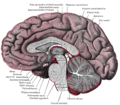Pineal gland
| Pineal gland | |
|---|---|
 Pineal gland or epiphysis (in red) | |
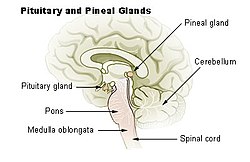 Diagram of pituitary and pineal glands in the human brain | |
| Details | |
| Precursor | Neural ectoderm,roof ofdiencephalon |
| Artery | Posterior cerebral artery |
| Identifiers | |
| Latin | glandula pinealis |
| MeSH | D010870 |
| NeuroNames | 297 |
| NeuroLexID | birnlex_1184 |
| TA98 | A11.2.00.001 |
| TA2 | 3862 |
| FMA | 62033 |
| Anatomical terms of neuroanatomy | |
Thepineal gland(also known as thepineal body[1]orepiphysis cerebri) is a smallendocrine glandin thebrainof mostvertebrates.It producesmelatonin,aserotonin-derivedhormone,which modulatessleep patternsfollowing thediurnal cycles.[2]The shape of the gland resembles apine cone,which gives it its name.[3]The pineal gland is located in theepithalamus,near the center of the brain, between the twohemispheres,tucked in a groove where the two halves of thethalamusjoin.[4][5]It is one of theneuroendocrinesecretory circumventricular organsin which capillaries are mostlypermeabletosolutesin the blood.[6]
The pineal gland is present in almost all vertebrates, but is absent inprotochordatesin which there is a simple pineal homologue. Thehagfish,considered as a primitive vertebrate, has a rudimentary structure regarded as the "pineal equivalent" in the dorsaldiencephalon.[7]In some species of amphibians and reptiles, the gland is linked to a light-sensing organ, variously called theparietal eye,the pineal eye or the third eye.[8]Reconstruction of the biological evolution pattern suggests that the pineal gland was originally a kind of atrophiedphotoreceptorthat developed into a neuroendocrine organ.
Ancient Greeks were the first to notice the pineal gland and believed it to be a valve, a guardian for the flow ofpneuma.Galenin the 2nd centuryC.E.could not find any functional role and regarded the gland as a structural support for the brain tissue. He gave the namekonario,meaning cone or pinecone, which duringRenaissancewas translated to Latin aspinealis.The 17th century philosopherRené Descartesregarded the gland as having a mystical purpose, describing it as the "principal seat of the soul". In the mid-20th century, the biological role as a neuroendocrine organ was established.[9]
Etymology
[edit]The wordpineal,from Latinpinea(pine-cone) in reference to the gland's similar shape, was first used in the late 17th century.[3]
Structure
[edit]The pineal gland is a pine cone-shaped (hence the name), unpaired midline brain structure.[3][10]It is reddish-gray in colour and about the size of a grain of rice (5–8 mm) in humans. It forms part of theepithalamus.[1]It is attached to the rest of the brain by a pineal stalk.[11]The ventral lamina of the pineal stalk is continuous with theposterior commissure,and its dorsal lamina with thehabenular commissure.[11]
Location
[edit]It normally lies in a depression between the twosuperior colliculi.[11]It is situated between the laterally positionedthalamic bodies,and posterior to thehabenular commissure.It is located in thequadrigeminal cistern.[1]It is located posterior to thethird ventricleand encloses the small,cerebrospinal fluid-filled pineal recess of the third ventricle which projects into the stalk of the gland.[12]
Blood supply
[edit]Unlike most of the mammalian brain, the pineal gland is not isolated from the body by theblood–brain barriersystem;[13]it has profuse blood flow, second only to thekidney,[14]supplied from the choroidal branches of theposterior cerebral artery.
Afferents
[edit]The afferent nerve supply of pineal gland is by the nervus conarii which receives postganglionicsympatheticafferents from thesuperior cervical ganglion,[15]andparasympatheticafferents from thepterygopalatine gangliaandotic ganglia.[15][16]According to research on animals, neurons of thetrigeminal ganglionthat are involved inpituitary adenylate cyclase-activating peptideneuropeptidesignaling project the gland.[17][16]
Neural pathway for melatonin production
[edit]The canonical neural pathway regulating pineal melatonin production begins in the eye with the intrinsically photosensitive ganglion cells of the retina which project inhibitory GABAergic efferents to theparaventricular nucleus of hypothalamusvia theretinohypothalamic tract.The paraventricular nucleus in turn projects to the superior cervical ganglia, which finally projects to the pineal gland. Darkness thus leads to disinhibition of the paraventricular nucleus, leading it to activate pineal gland melatonin production by way of the superior cervical ganglia.[18]
Microanatomy
[edit]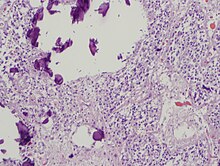
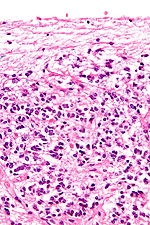
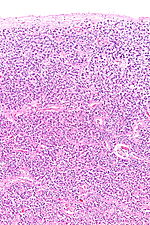
The pineal body in humans consists of a lobularparenchymaofpinealocytessurrounded byconnective tissuespaces. The gland's surface is covered by apialcapsule.
The pineal gland consists mainly ofpinealocytes,but four othercelltypes have been identified. As it is quite cellular (in relation to the cortex and white matter), it may be mistaken for aneoplasm.[19]
| Cell type | Description |
|---|---|
| Pinealocytes | The pinealocytes consist of a cell body with 4–6 processes emerging. They produce and secretemelatonin.The pinealocytes can be stained by special silver impregnation methods. Their cytoplasm is lightlybasophilic.With special stains, pinealocytes exhibit lengthy, branched cytoplasmic processes that extend to the connective septa and its blood vessels. |
| Interstitial cells | Interstitial cells are located between the pinealocytes. They have elongated nuclei and a cytoplasm that is stained darker than that of the pinealocytes. |
| Perivascularphagocyte | Many capillaries are present in the gland, and perivascular phagocytes are located close to these blood vessels. The perivascular phagocytes areantigenpresenting cells. |
| Pinealneurons | Inhigher vertebratesneurons are usually located in the pineal gland. However, this is not the case in rodents. |
| Peptidergicneuron-like cells | In some species, neuronal-like peptidergic cells are present. These cells might have a paracrine regulatory function. |
Development
[edit]The human pineal gland grows in size until about 1–2 years of age, remaining stable thereafter,[20][21]although its weight increases gradually from puberty onwards.[22][23]The abundant melatonin levels in children are believed to inhibit sexual development, and pineal tumors have been linked withprecocious puberty.When puberty arrives, melatonin production is reduced.[24]
Symmetry
[edit]In thezebrafishthe pineal gland does not straddle the midline, but shows a left-sided bias. Inhumans,functional cerebral dominance is accompanied by subtle anatomical asymmetry.[25][26][27]
Function
[edit]One function of the pineal gland is to producemelatonin.Melatonin has various functions in thecentral nervous system,the most important of which is to help modulate sleep patterns. Melatonin production is stimulated by darkness and inhibited by light.[28][29]Light sensitive nerve cellsin the retina detect light and send this signal to thesuprachiasmatic nucleus(SCN), synchronizing the SCN to the day-night cycle. Nerve fibers then relay the daylight information from the SCN to theparaventricular nuclei(PVN), then to thespinal cordand via the sympathetic system tosuperior cervical ganglia(SCG), and from there into the pineal gland.
The compoundpinolineis also claimed to be produced in the pineal gland; it is one of thebeta-carbolines.[30]This claim is subject to some controversy.[citation needed]
Regulation of the pituitary gland
[edit]Studies on rodents suggest that the pineal gland influences thepituitary gland's secretion of the sex hormones,follicle-stimulating hormone(FSH), andluteinizing hormone(LH).Pinealectomyperformed on rodents produced no change in pituitary weight, but caused an increase in the concentration of FSH and LH within the gland.[31]Administration ofmelatonindid not return the concentrations of FSH to normal levels, suggesting that the pineal gland influences pituitary gland secretion of FSH and LH through an undescribed transmitting molecule.[31]
The pineal gland containsreceptorsfor the regulatoryneuropeptide,endothelin-1,[32]which, when injected inpicomolarquantities into thelateral cerebral ventricle,causes acalcium-mediated increase in pinealglucose metabolism.[33]
Regulation of bone metabolism
[edit]Studies in mice suggest that the pineal-derived melatonin regulates new bone deposition. Pineal-derived melatonin mediates its action on the bone cells through MT2 receptors. This pathway could be a potential new target for osteoporosis treatment as the study shows the curative effect of oral melatonin treatment in a postmenopausal osteoporosis mouse model.[34]
Clinical significance
[edit]Calcification
[edit]Calcificationof the pineal gland is typical in young adults, and has been observed in children as young as two years of age.[35]The internal secretions of the pineal gland are known to inhibit the development of the reproductive glands because when it is severely damaged in children, development of the sexual organs and the skeleton are accelerated.[36]Pineal gland calcification is detrimental to its ability to synthesize melatonin[37][38]and scientific literature presents inconclusive findings on whether it causes sleep problems.[39][40]
The calcified gland is often seen in skullX-rays.[35]Calcification rates vary widely by country and correlate with an increase in age, with calcification occurring in an estimated 40% of Americans by age seventeen.[35]Calcification of the pineal gland is associated withcorpora arenacea,also known as "brain sand".
Tumors
[edit]Tumorsof the pineal gland are calledpinealomas.These tumors are rare and 50% to 70% aregerminomasthat arise from sequestered embryonicgerm cells.Histologicallythey are similar to testicularseminomasand ovariandysgerminomas.[41]
A pineal tumor can compress thesuperior colliculiandpretectal areaof the dorsalmidbrain,producingParinaud's syndrome.Pineal tumors also can cause compression of thecerebral aqueduct,resulting in a noncommunicatinghydrocephalus.Other manifestations are the consequence of their pressure effects and consist of visual disturbances,headache,mental deterioration, and sometimes dementia-like behaviour.[42]
Theseneoplasmsare divided into three categories: pineoblastomas,pineocytomas,and mixed tumors, based on their level of differentiation, which, in turn, correlates with their neoplastic aggressiveness.[43]The clinical course of patients with pineocytomas is prolonged, averaging up to several years.[44]The position of these tumors makes them difficult to remove surgically.
Other conditions
[edit]The morphology of the pineal gland differs markedly in different pathological conditions. For instance, it is known that its volume is reduced in bothobesepatients and those with primaryinsomnia.[45]
Other animals
[edit]Nearly all vertebrate species possess a pineal gland. The most important exception is a primitive vertebrate, thehagfish.Even in the hagfish, however, there may be a "pineal equivalent" structure in the dorsaldiencephalon.[7]A few more complex vertebrates have lost pineal glands over the course of their evolution.[46]Thelamprey(another primitive vertebrate), however, does possess one.[47]ThelanceletBranchiostoma lanceolatum,an early chordate which is a close relative to vertebrates, also lacks a recognizable pineal gland.[47]Protochordates in general do not have the distinct structure as an organ, but they have a mass of photoreceptor cells calledlamellar body,which is regarded as a pineal homologue.[48][49]
The results of various scientific research in evolutionary biology, comparative neuroanatomy and neurophysiology have explained the evolutionary history (phylogeny) of the pineal gland in different vertebrate species. From the point of view of biological evolution, the pineal gland is a kind of atrophiedphotoreceptor.In theepithalamusof some species of amphibians and reptiles, it is linked to a light-sensing organ, known as theparietal eye,which is also called the pineal eye orthird eye.[8]It is likely that thecommon ancestorof allvertebrateshad a pair of photosensory organs on the top of its head, similar to the arrangement in modernlampreys.[50]In many lower vertebrates (such as species of fish, amphibians and lizards), the pineal gland is associated withparietal or pineal eye.In these animals, the parietal eye acts as a photoreceptor, and hence are also known as the third eye, and they can be seen on top of the head in some species.[51]Some extinctDevonianfishes have two parietal foramina in their skulls,[52][53]suggesting an ancestral bilaterality of parietal eyes. The parietal eye and the pineal gland of livingtetrapodsare probably the descendants of the left and right parts of this organ, respectively.[54]
Duringembryonicdevelopment, theparietal eyeand the pineal organ of modernlizards[55]andtuataras[56]form together from a pocket formed in the brainectoderm.The loss of parietal eyes in many living tetrapods is supported by developmental formation of a paired structure that subsequently fuses into a single pineal gland in developing embryos of turtles, snakes, birds, and mammals.[57]
The pineal organs of mammals fall into one of three categories based on shape. Rodents have more structurally complex pineal glands than other mammals.[58]
Crocodiliansand some tropical lineages of mammals (somexenarthrans(sloths),pangolins,sirenians(manateesanddugongs), and somemarsupials(sugar gliders)) have lost both their parietal eye and their pineal organ.[59][60][58]Polar mammals, such as walruses and some seals, possess unusually large pineal glands.[59]
All amphibians have a pineal organ, but some frogs and toads also have what is called a "frontal organ", which is essentially a parietal eye.[61]
Pinealocytesin many non-mammalianvertebrateshave a strong resemblance to thephotoreceptor cellsof theeye.Evidence from morphology and developmental biology suggests that pineal cells possess a commonevolutionaryancestor with retinal cells.[62]
Pinealcytostructureseems to have evolutionary similarities to the retinal cells of the lateral eyes.[62]Modernbirdsandreptilesexpress thephototransducingpigmentmelanopsinin the pineal gland. Avian pineal glands are thought to act like thesuprachiasmatic nucleusinmammals.[63]The structure of the pineal eye in modern lizards and tuatara is analogous to the cornea, lens, and retina of the lateral eyes of vertebrates.[57]
In most vertebrates, exposure to light sets off a chain reaction of enzymatic events within the pineal gland that regulatescircadian rhythms.[64]In humans and other mammals, the light signals necessary to set circadian rhythms are sent from the eye through theretinohypothalamicsystem to thesuprachiasmatic nuclei(SCN) and the pineal gland.
The fossilized skulls of many extinct vertebrates have a pinealforamen(opening), which in some cases is larger than that of any living vertebrate.[65]Although fossils seldom preserve deep-brain soft anatomy, the brain of the Russian fossil birdCerebavis cenomanicafrom Melovatka, about 90 million years old, shows a relatively large parietal eye and pineal gland.[66]
History
[edit]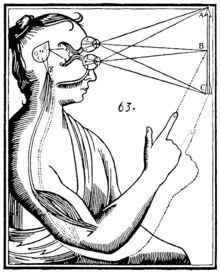
The secretory activity of the pineal gland is only partially understood. Its location deep in the brain suggested to philosophers throughout history that it possessed particular importance. This combination led to its being regarded as a "mystery" gland withmystical,metaphysical,andocculttheories surrounding its perceived functions. The earliest recorded description of the pineal gland is from the Greek physicianGalenin the 2nd century C.E.[67]According to Galen,Herophilus(325–280 B.C.E.) had already considered the structure as a kind of valve that partitioned the brain chambers, particularly for the flow of vital spirits (pneuma).[68]Specifically, the ancient Greeks believed that the structure maintained the movement of vital spirits from the middle (now identified as thethird) ventricle to the one in the parencephalis (fourth ventricle).[69][70]
Galen described the pineal gland inDe usu partium corporis humani, libri VII(On the Usefulness of Parts of the Body, Part 8) andDe anatomicis administrationibus,libri IX(On Anatomical Procedures, Part 9).[71]He introduced the nameκωνάριο(konario,often Latinised asconarium) that means cone, as in pinecone,[72]inDe usu partium corporis humani.He correctly located the gland as directly lying behind the third ventricle. He argued against the prevailing concept of it as a valve for two basic reasons: it is located outside of the brain tissue and it does not move on its own.[67]
Galen instead identified the valve as a worm-like structure in thecerebellum(later called vermiform epiphysis, known today as thevermis cerebelliorcerebellar vermis).[73]From his study on the blood vessels surrounding the pineal gland he discovered the great vein of the cerebellum, later called thevein of Galen.[72][74]He could not establish any functional role of the pineal gland and regarded it as a structural support for the cerebral veins.[75]
Seventeenth-century philosopher and scientistRené Descartesdiscussed the pineal gland both in his first book, theTreatise of Man(written before 1637, but only published posthumously 1662/1664), and in his last book,The Passions of the Soul(1649) and he regarded it as "the principal seat of the soul and the place in which all our thoughts are formed".[9]In theTreatise of Man,he described conceptual models of man, namely creatures created by God, which consist of two ingredients, a body and a soul.[9][76]In thePassions,he split man up into a body and a soul and emphasized that the soul is joined to the whole body by "a certain very small gland situated in the middle of the brain's substance and suspended above the passage through which the spirits in the brain's anterior cavities communicate with those in its posterior cavities". Descartes gave importance to the structure as it was the only unpaired component of the brain.[9]
The Latin namepinealisbecame popular in the 17th century. For example, English physicianThomas Willisdescribed aglandula pinealisin his book,Cerebri anatome cui accessit nervorum descriptio et usus(1664).Willis criticised Descartes' concept, remarking: "we can scarce[ly] believe this to be the seat of the Soul, or its chief Faculties to arise from it; because Animals, which seem to be almost quite destitute of Imagination, Memory, and other superior Powers of the Soul, have this Glandula or Kernel large and fair enough."[75]
Walter Baldwin Spencerat the University of Oxford gave the first description of the pineal gland in lizards. In 1886, he described an eye-like structure, which he called the pineal eye or parietal eye, that was associated with theparietal foramenand the pineal stalk.[77]The presence of a pineal body was already discovered by German zoologist Franz Leydig in 1872, in European lizards. Leydig called them the "frontal organ" (Germanstirnorgan).[78][79]In 1918, Swedish zoologistNils Holmgrendescribed the "parietal eye" in frogs and dogfish.[80]He discovered that the parietal eyes were made up of sensory cells similar to thecone cellsof the retina,[75]and suggested that it was a primitive light-sensor organ (photoreceptor).[80]
The pineal gland was originally believed to be a "vestigialremnant "of a larger organ. In 1917, it was known that extract of cow pineals lightened frog skin. Dermatology professorAaron B. Lernerand colleagues atYale University,hoping that a hormone from the pineal gland might be useful in treating skin diseases, isolated it and named itmelatoninin 1958.[81]The substance did not prove to be helpful as intended, but its discovery helped solve several mysteries, such as why removing a rat's pineal gland accelerated its ovary growth, why keeping rats in constant light decreased the weight of their pineals, and why pinealectomy and constant light affect ovary growth to an equal extent; this knowledge gave a boost to the then-new field ofchronobiology.[82]Of the endocrine organs, the function of the pineal gland was the last to be discovered.[83]
Society and culture
[edit]The notion of a "pineal-eye" is central to the philosophy of the French writerGeorges Bataille,which is analyzed at length by literary scholar Denis Hollier in his studyAgainst Architecture.In this work Hollier discusses how Bataille uses the concept of a "pineal-eye" as a reference to a blind-spot in Western rationality, and an organ of excess and delirium.[84]This conceptual device is explicit in his surrealist texts,The JesuveandThe Pineal Eye.[85]
In the late 19th centuryMadame Blavatsky,founder oftheosophy,identified the pineal gland with the Hindu concept of thethird eye,or theAjna chakra.This association is still popular today.[9]The pineal gland has also featured in other religious contexts, such as in thePrincipia Discordia,which claims it can be used to contact the goddess of discordEris.[86]
In the short story "From Beyond"byH. P. Lovecraft,a scientist creates an electronic device that emits a resonance wave, which stimulates an affected person's pineal gland, thereby allowing them to perceive planes of existence outside the scope ofaccepted reality,a translucent, alien environment that overlaps our own recognized reality. It was adapted as afilm of the same namein 1986. The 2013 horror filmBanshee Chapteris heavily influenced by this short story. In Season 16, episode 6 of "American Dad" Steve tries to "astral project" using his pineal gland to help him understand the meaning of life. The episode is entitled "The Wondercabinet".
Additional images
[edit]The pineal body is labeled in these images.
-
Mesal aspect of a brain sectioned in the median sagittal plane
-
Dissection showing the ventricles of the brain
-
Hind- and mid-brains; antero-lateral view
-
Median sagittal section of brain
-
Pineal gland
-
Brainstem; posterior view
See also
[edit]References
[edit]- ^abcChen CY, Chen FH, Lee CC, Lee KW, Hsiao HS (October 1998)."Sonographic characteristics of the cavum velum interpositum"(PDF).AJNR. American Journal of Neuroradiology.19(9): 1631–1635.PMC8337493.PMID9802483.
- ^Reiter, R. J. (November 1991). "Neuroendocrine effects of light".International Journal of Biometeorology.35(3): 169–175.doi:10.1007/BF01049063.ISSN0020-7128.PMID1778647.
- ^abc"Pineal (as an adjective)".Online Etymology Dictionary, Douglas Harper. 2018.Retrieved27 October2018.
- ^Macchi MM, Bruce JN (2004). "Human pineal physiology and functional significance of melatonin".Frontiers in Neuroendocrinology.25(3–4): 177–195.doi:10.1016/j.yfrne.2004.08.001.PMID15589268.S2CID26142713.
- ^Arendt J, Skene DJ (February 2005). "Melatonin as a chronobiotic".Sleep Medicine Reviews.9(1): 25–39.doi:10.1016/j.smrv.2004.05.002.PMID15649736.
Exogenous melatonin has acute sleepiness-inducing and temperature-lowering effects during 'biological daytime', and when suitably timed (it is most effective around dusk and dawn) it will shift the phase of the human circadian clock (sleep, endogenous melatonin, cortisol) to earlier (advance phase shift) or later (delay phase shift) times.
- ^Gross PM, Weindl A (December 1987)."Peering through the windows of the brain".Journal of Cerebral Blood Flow and Metabolism.7(6): 663–672.doi:10.1038/jcbfm.1987.120.PMID2891718.S2CID18748366.
- ^abOoka-Souda S, Kadota T, Kabasawa H (December 1993). "The preoptic nucleus: the probable location of the circadian pacemaker of the hagfish, Eptatretus burgeri".Neuroscience Letters.164(1–2): 33–36.doi:10.1016/0304-3940(93)90850-K.PMID8152610.S2CID40006945.
- ^abEakin RM(1973).The Third Eye.Berkeley: University of California Press.
- ^abcdeLokhorst GJ (2018). Zalta EN (ed.)."Descartes and the Pineal Gland; In: The Stanford Encyclopedia of Philosophy"(Winter 2018 ed.). Metaphysics Research Lab, Stanford University.Retrieved17 December2019.
- ^Bowen R."The Pineal Gland and Melatonin".Archivedfrom the original on 24 November 2011.Retrieved14 October2011.
- ^abcWaxman SG (2009).Clinical Neuroanatomy(26th ed.). New York: McGraw-Hill Medical. p. 127.ISBN978-0-07-160399-7.
- ^Dorland's (2 May 2011).Illustrated Medical Dictionary.Elsevier Saunders. p. 1607.ISBN978-1-4160-6257-8.
- ^Pritchard TC, Alloway KD (1999).Medical Neuroscience(Google books preview).Hayes Barton Press. pp. 76–77.ISBN978-1-889325-29-3.Retrieved8 February2009.
- ^Arendt J: Melatonin and the Mammalian Pineal Gland, ed 1. London. Chapman & Hall, 1995, p 17
- ^abMøller M, Baeres FM (July 2002). "The anatomy and innervation of the mammalian pineal gland".Cell and Tissue Research.309(1): 139–150.doi:10.1007/s00441-002-0580-5.PMID12111544.S2CID25719864.
- ^abMøller M, Baeres FM (September 2003). "PACAP-containing intrapineal nerve fibers originate predominantly in the trigeminal ganglion: a combined retrograde tracing- and immunohistochemical study of the rat".Brain Research.984(1–2): 160–169.doi:10.1016/s0006-8993(03)03127-5.PMID12932850.S2CID40328108.
- ^Liu W, Møller M (September 2000). "Innervation of the rat pineal gland by PACAP-immunoreactive nerve fibers originating in the trigeminal ganglion: a degeneration study".Cell and Tissue Research.301(3): 369–373.doi:10.1007/s004410000251.PMID10994782.S2CID5763932.
- ^Tonon AC, Pilz LK, Markus RP, Hidalgo MP, Elisabetsky E (8 April 2021)."Melatonin and Depression: A Translational Perspective From Animal Models to Clinical Studies".Frontiers in Psychiatry.12:638981.doi:10.3389/fpsyt.2021.638981.PMC8060443.PMID33897495.
- ^Kleinschmidt-DeMasters BK, Prayson RA (November 2006). "An algorithmic approach to the brain biopsy--part I".Archives of Pathology & Laboratory Medicine.130(11): 1630–1638.doi:10.5858/2006-130-1630-AAATTB.PMID17076524.
- ^Schmidt F, Penka B, Trauner M, Reinsperger L, Ranner G, Ebner F, Waldhauser F (April 1995). "Lack of pineal growth during childhood".The Journal of Clinical Endocrinology and Metabolism.80(4): 1221–1225.doi:10.1210/jcem.80.4.7536203.PMID7536203.
- ^Sumida M, Barkovich AJ, Newton TH (February 1996)."Development of the pineal gland: measurement with MR".AJNR. American Journal of Neuroradiology.17(2): 233–236.PMC8338352.PMID8938291.
- ^Tapp E, Huxley M (September 1971). "The weight and degree of calcification of the pineal gland".The Journal of Pathology.105(1): 31–39.doi:10.1002/path.1711050105.PMID4943068.S2CID38346296.
- ^Tapp E, Huxley M (October 1972). "The histological appearance of the human pineal gland from puberty to old age".The Journal of Pathology.108(2): 137–144.doi:10.1002/path.1711080207.PMID4647506.S2CID28529644.
- ^"Melatonin Production and Age".Chronobiology.Medichron Publications.
- ^Snelson CD, Santhakumar K, Halpern ME, Gamse JT (May 2008)."Tbx2b is required for the development of the parapineal organ".Development.135(9): 1693–1702.doi:10.1242/dev.016576.PMC2810831.PMID18385257.
- ^Snelson CD, Burkart JT, Gamse JT (December 2008)."Formation of the asymmetric pineal complex in zebrafish requires two independently acting transcription factors".Developmental Dynamics.237(12): 3538–3544.doi:10.1002/dvdy.21607.PMC2810829.PMID18629869.
- ^Snelson CD, Gamse JT (June 2009)."Building an asymmetric brain: development of the zebrafish epithalamus".Seminars in Cell & Developmental Biology.20(4): 491–497.doi:10.1016/j.semcdb.2008.11.008.PMC2729063.PMID19084075.
- ^Axelrod J (September 1970). "The pineal gland".Endeavour.29(108): 144–148.PMID4195878.
- ^Lowrey PL, Takahashi JS (2000). "Genetics of the mammalian circadian system: Photic entrainment, circadian pacemaker mechanisms, and posttranslational regulation".Annual Review of Genetics.34(1): 533–562.doi:10.1146/annurev.genet.34.1.533.PMID11092838.
- ^Callaway JC, Gyntber J, Poso A, Airaksinen MM, Vepsäläinen J (1994). "The pictet-spengler reaction and biogenic tryptamines: Formation of tetrahydro-β-carbolines at physiologicalpH".Journal of Heterocyclic Chemistry.31(2): 431–435.doi:10.1002/jhet.5570310231.
- ^abMotta M, Fraschini F, Martini L (November 1967). "Endocrine effects of pineal gland and of melatonin".Proceedings of the Society for Experimental Biology and Medicine.126(2): 431–435.doi:10.3181/00379727-126-32468.PMID6079917.S2CID28964258.
- ^Naidoo V, Naidoo S, Mahabeer R, Raidoo DM (May 2004). "Cellular distribution of the endothelin system in the human brain".Journal of Chemical Neuroanatomy.27(2): 87–98.doi:10.1016/j.jchemneu.2003.12.002.PMID15121213.S2CID39053816.
- ^Gross PM, Wainman DS, Chew BH, Espinosa FJ, Weaver DF (March 1993). "Calcium-mediated metabolic stimulation of neuroendocrine structures by intraventricular endothelin-1 in conscious rats".Brain Research.606(1): 135–142.doi:10.1016/0006-8993(93)91581-C.PMID8461995.S2CID12713010.
- ^Sharan K, Lewis K, Furukawa T, Yadav VK (September 2017)."Regulation of bone mass through pineal-derived melatonin-MT2 receptor pathway".Journal of Pineal Research.63(2): e12423.doi:10.1111/jpi.12423.PMC5575491.PMID28512916.
- ^abcZimmerman RA, Bilaniuk LT (March 1982)."Age-related incidence of pineal calcification detected by computed tomography"(PDF).Radiology.142(3). Radiological Society of North America: 659–662.doi:10.1148/radiology.142.3.7063680.PMID7063680.Archived fromthe original(PDF)on 24 March 2012.Retrieved21 June2012.
- ^"The Pineal Body".Human Anatomy (Gray's Anatomy).Archivedfrom the original on 26 August 2011.Retrieved7 September2011.
- ^Kunz D, Schmitz S, Mahlberg R, Mohr A, Stöter C, Wolf KJ, Herrmann WM (December 1999)."A new concept for melatonin deficit: on pineal calcification and melatonin excretion".Neuropsychopharmacology.21(6): 765–772.doi:10.1016/S0893-133X(99)00069-X.PMID10633482.S2CID20184373.
- ^Tan DX, Xu B, Zhou X, Reiter RJ (January 2018)."Pineal Calcification, Melatonin Production, Aging, Associated Health Consequences and Rejuvenation of the Pineal Gland".Molecules.23(2): 301.doi:10.3390/molecules23020301.PMC6017004.PMID29385085.
- ^Del Brutto OH, Mera RM, Lama J, Zambrano M, Castillo PR (November 2014). "Pineal gland calcification is not associated with sleep-related symptoms. A population-based study in community-dwelling elders living in Atahualpa (rural coastal Ecuador)".Sleep Medicine.15(11): 1426–1427.doi:10.1016/j.sleep.2014.07.008.PMID25277665.
- ^Mahlberg R, Kienast T, Hädel S, Heidenreich JO, Schmitz S, Kunz D (April 2009). "Degree of pineal calcification (DOC) is associated with polysomnographic sleep measures in primary insomnia patients".Sleep Medicine.10(4): 439–445.doi:10.1016/j.sleep.2008.05.003.PMID18755628.
- ^Kumar V, Abbas AK, Aster JC (5 September 2014).Robbins & Cotran Pathologic Basis of Disease.Elsevier Health Sciences. p. 1137.ISBN9780323296359.
- ^Bruce J."Pineal Tumours".eMedicine.Archivedfrom the original on 5 September 2015.Retrieved25 September2015.
- ^"Pineal Tumours".American Brain Tumour Association.Archivedfrom the original on 26 September 2015.Retrieved25 September2015.
- ^Clark AJ, Sughrue ME, Ivan ME, Aranda D, Rutkowski MJ, Kane AJ, et al. (November 2010)."Factors influencing overall survival rates for patients with pineocytoma".Journal of Neuro-Oncology.100(2): 255–260.doi:10.1007/s11060-010-0189-6.PMC2995321.PMID20461445.
- ^Tan DX, Xu B, Zhou X, Reiter RJ (January 2018)."Pineal Calcification, Melatonin Production, Aging, Associated Health Consequences and Rejuvenation of the Pineal Gland".Molecules.23(2): 301.doi:10.3390/molecules23020301.PMC6017004.PMID29385085.S2CID25611663.
- ^Erlich SS, Apuzzo ML (September 1985). "The pineal gland: anatomy, physiology, and clinical significance".Journal of Neurosurgery.63(3): 321–341.doi:10.3171/jns.1985.63.3.0321.PMID2862230.S2CID29929205.
- ^abVernadakis AJ, Bemis WE, Bittman EL (April 1998). "Localization and partial characterization of melatonin receptors in amphioxus, hagfish, lamprey, and skate".General and Comparative Endocrinology.110(1): 67–78.doi:10.1006/gcen.1997.7042.PMID9514841.
- ^Lacalli TC (March 2008). "Basic features of the ancestral chordate brain: a protochordate perspective".Brain Research Bulletin.75(2–4): 319–323.doi:10.1016/j.brainresbull.2007.10.038.PMID18331892.S2CID25837046.
- ^Ivashkin E, Adameyko I (April 2013)."Progenitors of the protochordate ocellus as an evolutionary origin of the neural crest".EvoDevo.4(1): 12.doi:10.1186/2041-9139-4-12.PMC3626940.PMID23575111.
- ^Cole WC, Youson JH (October 1982). "Morphology of the pineal complex of the anadromous sea lamprey, Petromyzon marinus L".The American Journal of Anatomy.165(2): 131–163.doi:10.1002/aja.1001650205.PMID7148728.
- ^Dodt E (1973), Jung R (ed.),"The Parietal Eye (Pineal and Parietal Organs) of Lower Vertebrates",Visual Centers in the Brain,Handbook of Sensory Physiology, vol. 7 / 3 / 3 B, Berlin, Heidelberg: Springer Berlin Heidelberg, pp. 113–140,doi:10.1007/978-3-642-65495-4_4,ISBN978-3-642-65497-8,retrieved28 March2023
- ^Cope ED (1888). "The pineal eye in extinct vertebrates".American Naturalist.22(262): 914–917.doi:10.1086/274797.S2CID85280810.
- ^Schultze HP (1993)."Patterns of diversity in the skulls of jawed fishes".In Hanken J, Hall BK (eds.).The Skull.Vol. 2: Patterns of Structural and Systematic Diversity. Chicago, Illinois: University of Chicago Press. pp. 189–254.ISBN9780226315683.Retrieved2 February2017.
- ^Dodt E (1973). "The parietal eye (pineal and parietal organs) of lower vertebrates".Visual Centers in the Brain.Springer. pp. 113–140.
- ^Tosini G (1997). "The pineal complex of reptiles: physiological and behavioral roles".Ethology Ecology & Evolution.9(4): 313–333.doi:10.1080/08927014.1997.9522875.
- ^Dendy A (1911)."On the structure, development and morphological interpretation of the pineal organs and adjacent parts of the brain in the tuatara (Sphenodon punctatus)".Philosophical Transactions of the Royal Society of London B.201(274–281): 227–331.doi:10.1098/rstb.1911.0006.
- ^abQuay WB (1979)."The parietal eye–pineal complex".In Gans C, Northcutt RG, Ulinski P (eds.).Biology of the Reptilia. Volume 9. Neurology A.London: Academic Press. pp. 245–406.Archivedfrom the original on 3 February 2017.
- ^abVollrath L (1979).Comparative Morphology of the Vertebrate Pineal Complex.Progress in Brain Research. Vol. 52. pp. 25–38.doi:10.1016/S0079-6123(08)62909-X.ISBN9780444801142.PMID398532.
- ^abRalph CL (December 1975). "The pineal gland and geographical distribution of animals".International Journal of Biometeorology.19(4): 289–303.Bibcode:1975IJBm...19..289R.doi:10.1007/bf01451040.PMID1232070.S2CID30406445.
- ^Ralph C, Young S, Gettinger R, O'Shea TJ (1985). "Does the manatee have a pineal body?".Acta Zoologica.66:55–60.doi:10.1111/j.1463-6395.1985.tb00647.x.
- ^Adler K (April 1976). "Extraocular photoreception in amphibians".Photophysiology.23(4): 275–298.doi:10.1111/j.1751-1097.1976.tb07250.x.PMID775500.S2CID33692776.
- ^Natesan A, Geetha L, Zatz M (July 2002)."Rhythm and soul in the avian pineal".Cell and Tissue Research.309(1): 35–45.doi:10.1007/s00441-002-0571-6.PMID12111535.S2CID26023207.
- ^Moore RY, Heller A, Wurtman RJ, Axelrod J (January 1967). "Visual pathway mediating pineal response to environmental light".Science.155(3759): 220–223.Bibcode:1967Sci...155..220M.doi:10.1126/science.155.3759.220.PMID6015532.S2CID44377291.
- ^Edinger T (1955)."The size of parietal foramen and organ in reptiles: a rectification".Bulletin of the Museum of Comparative Zoology.114:1–34.Archivedfrom the original on 1 December 2017.
- ^Kurochkin EN, Dyke GJ, Saveliev SV, Pervushov EM, Popov EV (June 2007)."A fossil brain from the Cretaceous of European Russia and avian sensory evolution".Biology Letters.3(3): 309–313.doi:10.1098/rsbl.2006.0617.PMC2390680.PMID17426009.
- ^abShoja MM, Hoepfner LD, Agutter PS, Singh R, Tubbs RS (April 2016)."History of the pineal gland".Child's Nervous System.32(4): 583–586.doi:10.1007/s00381-015-2636-3.PMID25758643.S2CID26207380.
- ^Choudhry O, Gupta G, Prestigiacomo CJ (July 2011). "On the surgery of the seat of the soul: the pineal gland and the history of its surgical approaches".Neurosurgery Clinics of North America.22(3): 321–33, vii.doi:10.1016/j.nec.2011.04.001.PMID21801980.
- ^Berhouma M (September 2013). "Beyond the pineal gland assumption: a neuroanatomical appraisal of dualism in Descartes' philosophy".Clinical Neurology and Neurosurgery.115(9): 1661–1670.doi:10.1016/j.clineuro.2013.02.023.PMID23562082.S2CID9140909.
- ^Cardinali DP (2016). "The Prescientific Stage of the Pineal Gland".Ma Vie en Noir.Cham: Springer International Publishing. pp. 9–21.doi:10.1007/978-3-319-41679-3_2.ISBN978-3-319-41678-6.
- ^López-Muñoz F, Marín F, Álamo C (2016). "History of Pineal Gland as Neuroendocrine Organ and the Discovery of Melatonin". In López-Muñoz F, Srinivasan V, de Berardis D, Álamo C (eds.).Melatonin, Neuroprotective Agents and Antidepressant Therapy.New Delhi: Springer India. pp. 1–23.doi:10.1007/978-81-322-2803-5_1.ISBN978-81-322-2801-1.Retrieved28 March2023.
- ^abLaios K (July 2017)."The Pineal Gland and its earliest physiological description".Hormones.16(3): 328–330.doi:10.14310/horm.2002.1751.PMID29278521.
- ^Steinsiepe KF (January 2023). "The 'worm' in our brain. An anatomical, historical, and philological study on the vermis cerebelli".Journal of the History of the Neurosciences.32(3): 265–300.doi:10.1080/0964704X.2022.2146515.PMID36599122.S2CID255470624.
- ^Ustun C (September 2004). "Galen and his anatomic eponym: vein of Galen".Clinical Anatomy.17(6): 454–457.doi:10.1002/ca.20013.PMID15300863.
- ^abcPearce JM (2022)."The pineal: seat of the soul".Hektoen International.ISSN2155-3017.Retrieved28 March2023.
- ^Descartes R (2002). "The Passions of the Soul". In Chalmers D (ed.).Philosophy of the Mind.New York: Oxford University Press, Inc.ISBN978-0-19-514581-6.
- ^Spencer B (1885). "On the Presence and Structure of the Pineal Eye in Lacertilia".Quarterly Journal of Microscopy.London: Bartholomew Close. pp. 1–76.
- ^Flemming AF (1991)."A third eye".Culna(40): 26–27 – via Sabinet.
- ^Eakin RM (1973). "3 Structure".The Third Eye.University of California Press. pp. 32–84.doi:10.1525/9780520326323-004.ISBN978-0-520-32632-3.
- ^abWurtman RJ, Axelrod J (July 1965). "The Pineal Gland".Scientific American.213(1): 50–60.Bibcode:1965SciAm.213a..50W.doi:10.1038/scientificamerican0765-50.PMID14298722.
- ^Lerner AB, Case JD, Takahashi Y (July 1960)."Isolation of melatonin and 5-methoxyindole-3-acetic acid from bovine pineal glands".The Journal of Biological Chemistry.235(7): 1992–1997.doi:10.1016/S0021-9258(18)69351-2.PMID14415935.
- ^Coates PM, Blackman MR, Cragg GM, Levine M, Moss J, White JD (2005).Encyclopedia of Dietary Supplements.CRC Press. p. 457.ISBN978-0-8247-5504-1.Retrieved31 March2009.
- ^Sahai A, Sahai RJ (December 2013). "Pineal gland: A structural and functional Enigma".Journal of the Anatomical Society of India.62(2): 170–177.doi:10.1016/j.jasi.2014.01.001.
- ^Hollier D (1989).Against Architecture: The Writings of Georges Bataille.Translated by Wing B. MIT.
- ^Bataille G (1985).Visions of excess: Selected writings 1927-1939.Manchester University Press.
- ^"Principia Discordia - Page 15".principiadiscordia.Retrieved22 September2023.




